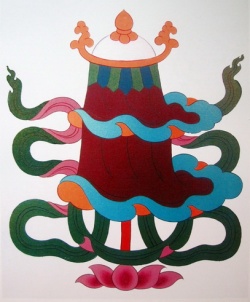The Buddha’s Many Biographies, 17th-18th c.
2011 Dissertation
Buddhism
Patricia Berger
UC Berkeley
A review of Adapting the Buddha’s Biographies: A Cultural History of the Wish-Fulfilling Vine in Tibet, Seventeenth to Eighteenth Centuries, by Nancy Grace Lin.
Scholars of Buddhist Studies, Tibetan Studies and Asian cultural history are provided a feast of knowledge in Nancy Lin’s dissertation on adaptations of a version of the Buddha’s biography called the Wish-Fulfilling Vine of Bodhisattva Avadānas (Skt. Bodhisattvāvadānakalpalatā; Tib. Byang chub sems dpa’i rtogs pa brjod pa dpag bsam ’khri shing), hereafter abbreviated as Wish-Fulfilling Vine. By viewing “adaptation” as a creative process, Lin skillfully narrates literary and artistic innovations of the Wish-Fulfilling Vine in Tibet during the seventeenth and eighteenth centuries.
This work kicks off with an erudite review of past scholarly approaches to Buddha’s biographies including the Wish-Fulfilling Vine, which will appeal to many scholars of Buddhist Studies. In the introduction, Lin also contextualizes the legacy of the Wish-Fulfilling Vine and its author Kṣemendra in Kashmir in order to highlight later Tibetan adaptations and interpretations. The approaches and methods used in the four subsequent chapters are in response to the question: “How did the Wish-Fulfilling Vine participate in the cultural imagination and discourse of Tibet?” (p. 13).
In order to answer this question, Lin creatively engaged with various cultural productions of the Wish-Fulfilling Vine by drawing upon adaptation theory, by contextualizing literary and pictorial forms of the Wish-Fulfilling Vine both diachronically and synchronically, and by analyzing the culture of elite Tibetan polymaths through literary, art-historical and historical approaches. As case studies, each chapter focuses on an important religious or political personage who had sponsored, designed, or promoted a cultural production of the Wish-Fulfilling Vine. Read as a whole, this dissertation provides unparalleled insight into Tibetan scholastic culture from the late Ming to the high Qing era.
The first chapter clearly demonstrates the range of ways in which a canonical text such as the Wish-Fulfilling Vine can be adapted to be used for political, literary and didactic purposes. The Fifth Dalai Lama (1617-1682) and his court promoted productions of the Wish-Fulfilling Vine in order to endorse an ideal of Indic cultural knowledge, which was adapted to fit a new vision of Tibetan government uniting secular political ideals with religious principles. The Great Fifth gave public instruction on the Wish-Fulfilling Vine at a crucial juncture in his career—at the Great Prayer Festival of the Iron-Snake Year [1641]—just prior to his ascension as both temporal and spiritual leader of Tibet and the formation of the Ganden Podrang government with the military support of the Khoshuud Mongol Güüshi Khan. Later, the Fifth Dalai Lama sponsored three major pictorial productions of the Wish-Fulfilling Vine (a set of scroll paintings and murals both at Drepung Monastery and the Potala Palace) and commissioned a bilingual Sanskrit-Tibetan xylographic edition. Drawing upon the Great Fifth’s autobiography, Lin illustrates the ways in which the Fifth Dalai Lama’s vision of state-building placed knowledge production in the hands of polymathic scholar-monks. Lin shows how the status of canonical texts remained in a state of flux, subject to criticism, neglect and reevaluation (pp. 58-65). These state-sponsored productions of the Wish-Fulfilling Vine inspired other statesmen and polymaths—the foci of the next three chapters.
Chapter two traces Polha family patronage of the Wish-Fulfilling Vine during their secular rule over Tibet from 1728-1750. After briefly sketching the political careers of Miwang Polhané (Tib. Mi dbang pho lha nas; ruled 1728-1747) and his son (’Gyur med rnam rgyal; ruled 1747-1750), Lin deftly balances meticulous art-historical analysis of two large-scale designs of the Wish-Fulfilling Vine (one xylographic, the other painted) with a socio-historical overview of Polhané’s vision of governance. On one hand, Polhané projected a new image of a “righteous cakravartin king modeled on Indian exemplars, and explicitly did so in his donor portrait and its inscription” (p. 87). On the other hand, Polhané was also identified as a tantric protector of the Dharma through his recognition as an emanation of Yamshu marpo (Tib. Yam shud dmar po)—who was considered both the king of a demon and a younger brother of the Buddha Śākyamuni in a previous life. Both of these adaptations exemplified Polhané’s violent rise to power and benevolent rule.
The monastic scholar Situ Paṇchen (1700-1774) serves as the focal point for the third chapter. As a prominent incarnate lama and head of the Kagyü order, Situ worked prolifically on the Buddha’s biographies to authenticate his order’s claims to Buddhist knowledge as well as a means to endorse a combination of religious discipline (especially celibacy) and scholastic erudition in lieu of sectarian attacks and the expansion of local lay tantric communities. After being effectively exiled to Dergé due to sectarianism, Situ became the chief editor on a court-sponsored production of the Tibetan Buddhist canon. In this process, Situ reinvigorated the art of Tibetan poetics and painting through his creative adaptation of the Wish-Fulfilling Vine in a set of twenty-three scroll paintings—beautifully analyzed by Lin through dialectics between Kṣemendra’s poetry and Situ’s interpretations (especially pp. 137-142).
The final chapter looks at the commissions of the Wish-Fulfilling Vine based on Situ Paṇchen’s design completed by the court chaplain of Dergé, Zhuchen Tsültrim Rinchen (1697-1774). As an erudite scholar, he critiqued the poor quality of Sanskrit in the bilingual xylographic edition of the Wish-Fulfilling Vine, which had been sponsored by the Fifth Dalai Lama (cf. chapter 1). Yet due to his lower-ranking societal position, he had no means to convince his powerful patron of the need to edit this work; nonetheless, the verse digest Zhuchen composed later in his life—masterfully translated by Lin (pp. 154-178)—likely served as a corrective of the earlier edition. Lin also brings to light textual evidence of painted renditions of the Wish-Fulfilling Vine where the paintings are no longer extant.
These various adaptations of Wish-Fulfilling Vine serve not only as a means to reconstruct the social and political milieu of the eminent figures featured here, but also shows the rich diversity and sophistication with which Tibetan scholars interpreted the Buddha’s biographies and applied them in their lives and social conditions. When published as a book, Adapting the Buddha’s Biographies will join the ranks of great scholarly contributions to Tibetan intellectual and cultural history.
Primary Sources
Textual: Tibetan Buddhist canon (both Kanjur and Tenjur); Tibetan-language auto/biographies including those by the Dalai Lama, Polhané, Situ Paṇchen and Zhuchen
Visual: images of pictorial productions of the Wish-Fulfilling Vine from murals, xylographs, and scroll paintings
Dissertation Information
University of California, Berkeley. 2011. 319 pp. Primary Advisors: Alexander von Rospatt and Patricia Berger.



